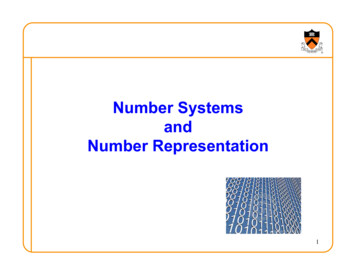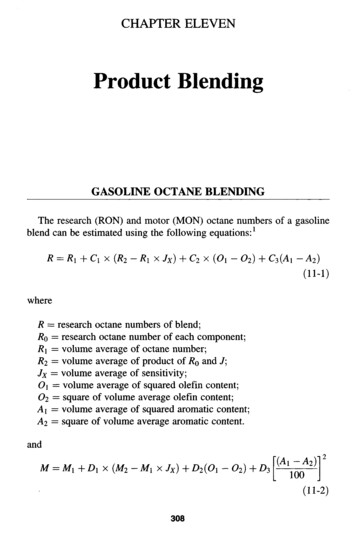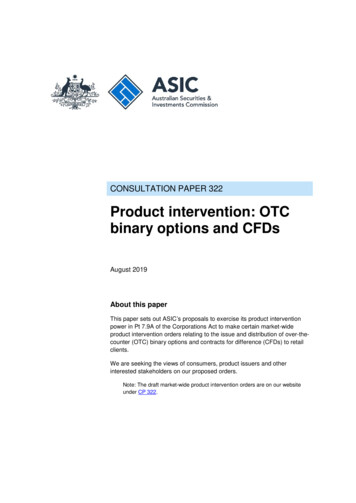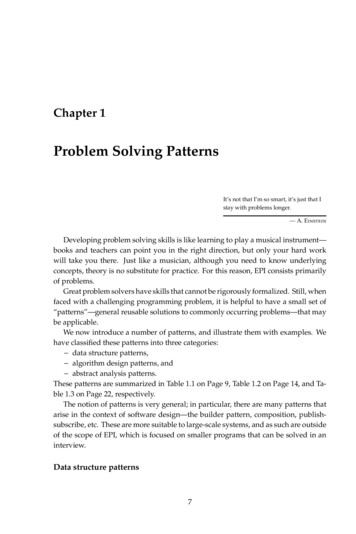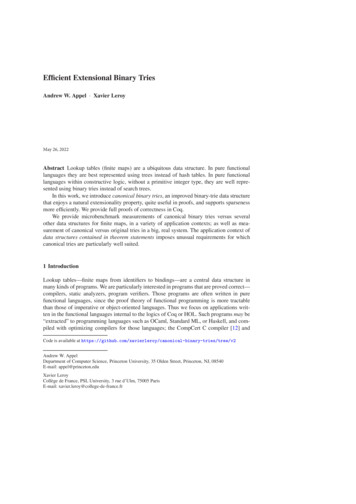
Transcription
Efficient Extensional Binary TriesAndrew W. Appel · Xavier LeroyMay 26, 2022Abstract Lookup tables (finite maps) are a ubiquitous data structure. In pure functionallanguages they are best represented using trees instead of hash tables. In pure functionallanguages within constructive logic, without a primitive integer type, they are well represented using binary tries instead of search trees.In this work, we introduce canonical binary tries, an improved binary-trie data structurethat enjoys a natural extensionality property, quite useful in proofs, and supports sparsenessmore efficiently. We provide full proofs of correctness in Coq.We provide microbenchmark measurements of canonical binary tries versus severalother data structures for finite maps, in a variety of application contexts; as well as measurement of canonical versus original tries in a big, real system. The application context ofdata structures contained in theorem statements imposes unusual requirements for whichcanonical tries are particularly well suited.1 IntroductionLookup tables—finite maps from identifiers to bindings—are a central data structure inmany kinds of programs. We are particularly interested in programs that are proved correct—compilers, static analyzers, program verifiers. Those programs are often written in purefunctional languages, since the proof theory of functional programming is more tractablethan those of imperative or object-oriented languages. Thus we focus on applications written in the functional languages internal to the logics of Coq or HOL. Such programs may be“extracted” to programming languages such as OCaml, Standard ML, or Haskell, and compiled with optimizing compilers for those languages; the CompCert C compiler [12] andCode is available at ies/tree/v2Andrew W. AppelDepartment of Computer Science, Princeton University, 35 Olden Street, Princeton, NJ, 08540E-mail: appel@princeton.eduXavier LeroyCollège de France, PSL University, 3 rue d’Ulm, 75005 ParisE-mail: xavier.leroy@college-de-france.fr
2A. W. Appel and X. Leroythe Verasco static analyzer [10] are examples. On the other hand, some programs, such asthe Verified Software Toolchain program verifier [1], don’t use extraction: those programsare reduced within the logic of a proof assistant, so that the program verifier can gracefullyinteract with user-driven interactive proof in the ambient logic.Many proved-correct programs of this kind deliberately use an impoverished set of primitives, so that fewer axioms need to be assumed (or equivalently, fewer lines of proof-checkerkernel code need to be trusted). In particular, there may be no primitive integer type implemented in a machine word. Instead, integers (or whatever type is used for keys, the domainof the finite maps) may be constructed from the inductive data types of the logic. Consequently, we cannot assume that a less-than comparison of two keys takes constant time; itwill be logarithmic in the magnitude of the numbers.These criteria led to a preliminary design for a data structure and its algebraic interface:binary tries, also called positive trees (for reasons that will become clear). This data structurewas used in the CompCert C compiler, the Verified Software Toolchain (VST), the Verascoverified static analyzer, and in other applications. In the process, we have learned to demandmore and more criteria of efficiency and provability from them:Core Requirements1. Basic operators: empty (the finite map with an empty domain), get (the lookup operator), and set (the update operator).2. Proofs1 of basic laws:get i empty None,get i (set i v m) Some v,i 6 j get i (set j v m) get i m.3. A purely functional implementation (which rules out hash tables, for example).4. A persistent semantics, so that set j v m does not destroy m; this arises naturally fromthe purely functional implementation.5. Efficient representation of keys.6. Efficient asymptotic time complexity of get and set operations, as extracted to OCaml.7. Linear-time computation of the list of key-binding pairs of a finite-map, in sorted orderby key, with proofs of its properties.8. Linear-time combining two finite maps m1 and m2 with function f yielding a map msuch that, at any key i, m(i) f (m1 (i), m2 (i)); with proofs of its properties.Extended Requirements9. Efficiency in the face of sparseness: that is, if the magnitude of individual keys is muchgreater than the number of keys bound in the map.10. Efficiency not only as extracted to OCaml (i.e., with proofs erased), but also as represented in Coq and computed within Coq (i.e., without proof erasure).11. Extensionality: the property that ( i. m1 (i) m2 (i)) m1 m2 . This allows Leibniz equality to be used in proofs about the larger systems in which the finite maps areembedded; otherwise, equivalence relations must be used, which is less convenient.The Core Requirements were all satisfied by a simple binary-trie data structure, implemented in CompCert and used 2005–2021 [15]. In section 2 we will present the datastructure and its operations, and discuss the proofs.In more recent applications, the Extended Requirements have been needed. Section 4describes a new variant of the data structure that has the extensionality property, handlessparseness better, and is significantly more efficient within Coq and somewhat more efficientas extracted to OCaml. It has been integrated in CompCert in 2021 [14]. Source code for1All proofs mentioned in this paper are machine-checked unless explicitly noted otherwise.
Efficient Extensional Binary Tries3implementations and proofs may also be found in the Coq development accompanying thisarticle [13].Extensionality could be achieved in other ways, such as sigma-types in Coq (the dependent pair of a data structure with a proof of its canonicity). We describe alternative implementations in section 6. Our benchmark measurements (section 7) show that our newvariant, “canonical binary tries” performs well in all contexts, while each of the alternativesis problematic in at least some contexts.Related work. Many lookup-table data structures have been implemented and proved correct in proof assistants. The books Verified Functional Algorithms [2] and Functional Algorithms Verified [17] each describe several pure-functional tree data structures with proofsof correctness (in Coq and Isabelle/HOL, respectively). They describe binary search trees,red-black trees, 2-3 trees, AVL trees, Braun trees, binary tries, Patricia tries. Of these,– Only Braun trees, binary tries, and Patricia tries avoid the assumption that comparisonsare constant-time.– Only red-black trees, 2-3 trees, AVL trees, and Patricia tries (but not Braun trees) handlesparseness efficiently.– Only Braun trees have the extensionality property. Braun trees support certain otheroperations, not supported by the other data structures (or by ours), useful for priorityqueues but not part of our core requirements.That is, none of the standard data structures satisfy our Core and Extended Requirements.A different approach would be to build single-threaded mutable arrays into the kernel ofthe logic, as was done long ago in ACL2 [6] and more recently in Coq. These do not satisfypersistence, except in a very inefficient way, nor sparseness.2 PTree: simple binary tries keyed by positive numbersA simple and efficient data structure for lookup tables (finite maps on integer or string keys)is the hash table. But this is not suitable for purely functional implementations, since theupdate operation is destructive.2Therefore one turns naturally to trees—for example, binary search trees. The lookupoperator in a balanced BST takes log N comparisons, and achieves asymptotic complexityof log N per operation only if comparison takes constant time. But Coq does not have aprimitive integer type with constant-time comparisons.3Coq’s logic, the Calculus of Inductive Constructions (CiC) encourages the constructionof types and operations, instead of axiomatization. For example, the natural numbers, andaddition upon them, are constructed as,Inductive nat : O : nat S : nat nat.Fixpoint add (n m : nat) : nat : match n with O m S p S (add p m) end.2 Persistent arrays give a functional semantics layered on an imperative (destructive-update) implementation, but these are not suitable because they would require extending the logic’s kernel of axioms.3 In fact, no programming language has a primitive integer type with constant-time comparisons; theytypically have a range-limited integer type 2k i 2k or a modular integer type (i mod 2k ). Most versionsof Coq 2005-present have not had a built-in integer type with fast comparisons; and relying on them wouldincrease the size of the trusted base, that is, Coq kernel code, Coq axioms, Coq extraction to OCaml, andOCaml operations upon which we rely.
4A. W. Appel and X. Leroyand then properties such as the associativity of add are proved as lemmas instead of beingaxiomatized.But this representation of natural numbers is not suitable for use as the keys of efficientlookup tables, because it is essentially a unary notation, in which representing the numbern takes space proportional to n, comparing n m takes time proportional to min(n, m), andso on. Therefore users of Coq often use a binary representation of integers, constructed asfollows:Inductive positive : Inductive Z : xI : positive positiveZ0 : Z Zpos : positive ZxO : positive positive xH : positive.Zneg : positive Z.The “meaning” of xH is the positive number 1; xO(p) represents 2p 0, and xI(p)represents 2p 1. Therefore the number 1310 11012 xI(xO(xI xH)), and the number0 is unrepresentable—these numbers truly are positive, not merely nonnegative.That means that the Z type (of binary unbounded signed integers) has the property ofextensionality—no two data structures of type Z represent the same mathematical integer.But the Z type is of no further concern in this paper; we will use positive as the type of keysfor lookup tables.The number p, represented as a positive, is represented with Θ (log p) constructors.When extracted to OCaml, this really means log p two-word records (in which the first wordcontains the constructor tag xI/xO/xH and the second word is a pointer to the remainder).That’s a lot more than the single word in which a native OCaml program or a C programmight use to represent an integer key, but it is efficient enough in practice, for the CompCertcompiler and similar applications.The positive number p, represented within Coq, also has log p constructors, but eachCoq construction is represented within the Coq kernel as two OCaml constructions thatdescribe the Coq constructor. So the number p occupies 5 log p words (or 8 · 5 log p bytes ona 64-bit machine). In practice this is usually efficient enough.4Given that Coq has this natural way to represent binary numbers using inductive datatypes, it is natural to use binary tries to implement lookup tables. A trie is a directed treein which every edge is labeled from a finite alphabet; a word (such as “cat”) is looked upby traversing the path of edges labeled sequentially with the letters of the word (such as“c” then “a” then “t”); and the nodes contain values of the range type of the lookup table.A binary trie is one in which the alphabet is {0, 1}.The implementation of binary tries, with positive keys, is straightforward in Coq:Inductive option (A: Type) : Some : A option A None : option A.Inductive tree (A : Type) : Leaf : tree A Node : tree A option A tree A tree A.Definition empty {A : Type} : tree A : Leaf.Fixpoint get {A : Type} (i : positive) (m : tree A) : option A : match m with Leaf None Node l o r match i with xH o xO i′ get i′ l xI i′ get i′ r endend.4 In OCaml, an arity-k constructor applied to arguments takes k 1 words, including one for theconstructor-tag. In Coq, an arity-k constructor is represented as one arity-2 OCaml construction plus onelength-k array, which take (respectively) 3 words and k 1 words as represented in OCaml within the Coqkernel. The arity-2 OCaml construction also points to a description of the constructor, but that description isshared among all its uses so we don’t count it.
Efficient Extensional Binary Tries5Fixpoint set {A : Type} (i : positive) (v : A) (m : tree A) : tree A : match m, i with Leaf, xH Node Leaf (Some v) Leaf Leaf, xO i′ Node (set i′ v Leaf) None Leaf Leaf, xI i′ Node Leaf None (set i′ v Leaf) Node l o r, xH Node l (Some v) r Node l o r, xO i′ Node (set i′ v l) o r Node l o r, xI i′ Node l o (set i′ v r)end.That is, each node of the tree is either a Leaf, meaning that no extension of the key leadingto this node is in the domain of the map, or an internal Node with left subtree l, optionalbinding-at-this-node o, and right subtree r. If o None then the key leading to this node isnot in the domain of the map, but some extensions of it might be. If o Some v then thekey leading to this node is mapped to v, and extensions of the key might also be mapped (inl and r). The edge from this node to subtree l is implicitly labeled by 0 (or xO), and the edgeto subtree r is implicitly labeled by 1 (or xI).Looking up a key p in a trie takes time proportional to the number of constructors representing the key, which is about log2 p; update is similarly efficient; this is efficient enoughfor many important applications, including CompCert.From these definitions it is easy to prove the important algebraic properties of maps:Theorem gempty: ( ‘‘get empty’’ ) (A: Type) (i: positive), get i (empty A) None.Proof. induction i; simpl; auto. Qed.Theorem gss: ( ‘‘get set same’’ ) (A: Type) (i: positive) (x: A) (m: tree A), get i (set i x m) Some x.Proof. induction i; destruct m; simpl; auto. Qed.Theorem gso: ( ‘‘get set other’’ ) (A: Type) (i j: positive) (x: A) (m: tree A), i j get i (set j x m) get i m.Proof. induction i; intros; destruct j; destruct m; simpl;try rewrite (gleaf A i); auto; try apply IHi; congruence.Qed.As usual in machine-checked proof scripts, the reader is not necessarily expected to readand understand the proofs; but the theorem statements should be clear, and induction i;destruct m suggests that the proof is by induction on the positive number i and then caseanalysis on m.In less than 50 lines of Coq we have accomplished the first 6 of the core requirements:the operators empty, get, set, proofs of the algebraic laws, a purely functional implementation with a persistent semantics, an efficient-enough representation of keys, and efficientenough asymptotic time complexity for many programs extracted to OCaml.Deletion (the remove operation) is similar to insertion (the set operation) but runs intoan issue: empty subtrees can be represented in several different ways, and the most compactrepresentation (namely, the Leaf constructor) should be favored.Fixpoint remove {A: Type} (i: positive) (m: tree A) : tree A : match m, i with Leaf, Leaf Node l o r, xH Node’ l None r Node l o r, xO i′ Node’ (remove i′ l) o r Node l o r, xI i′ Node’ l o (remove i′ r)end.
6A. W. Appel and X. LeroyIn the second case, if l and r are both Leaf, we do not want to build a useless empty subtreeNode Leaf None Leaf. This could also happen in the third and fourth cases if the recursivecall to remove returns Leaf. Empty nonleaf subtrees are not wrong, but they waste memory.So the solution is to use a Node’ pseudoconstructor function, as follows:Definition Node’ {A: Type} (l: tree A) (o: option A) (r: tree A): tree A : match l, o, r with Leaf, None, Leaf Leaf , , Node l x r end.Crucially, the pseudoconstructor Node’ behaves like the actual constructor Node with respect to the get operation:Lemma gNode’: (A: Type) (i: positive) (l: tree A) (o: option A) (r: tree A),get i (Node’ l o r) match i with xH x xO i′ get i′ l xI i′ get i′ r end.Proof.intros. destruct l, x, r; simpl; auto. destruct i; auto.Qed.This makes it easy to prove get-remove algebraic properties similar to the get-set properties.To produce an association list of the key-binding pairs, one could write a function suchas,Fixpoint elements {A} (m: tree A) (i: positive) : list (positive A) : match m with Leaf nil Node l o r elements l (xO i) match o with None nil Some x (prev i, x)::nil end elements r (xI i)end.where prev is positive-reversal, so prev(xI (xI (xO (xH))) xO (xI (xI xH)). However,this implementation is inefficient: since list-concatentation takes time proportional tothe length of its first argument, this function will take about N log N time for a tree containingN elements. So instead, one implements elements by accumulating the list to the right ofthe current tree, costing time exactly linear in the number of nodes in the tree. We will notshow the details.Proofs of the properties of the elements function are reasonably straightforward, thoughmore complex than the gso theorem.It is easy to define collective operations such as “map” and “filter” that transform afinite map into another finite map. For example, here is a map filter f operation that appliesa function f : A option B to every value a contained in a tree A map, discarding the valueif f a None.Fixpoint map filter {A B} (f: A option B) (m: tree A) : tree B : match m with Leaf Leaf Node l None r Node’ (map filter f l) None (map filter f r) Node l (Some a) r Node’ (map filter f l) (f a) (map filter f r)end.As in remove, we use the pseudoconstructor Node’ to avoid generating empty subtreesNode Leaf None Leaf.Many applications wish to combine two finite maps m1 : tree A, m2 : tree B with auser-supplied function f : option A option B option C. We assume thatf None None None, and we require that combine m1 m2 m if and only if i, f (m1(i))(m2 (i)) m(i).
Efficient Extensional Binary Tries7One might propose an implementation something like this:Fixpoint combine (m1 : tree A) (m2 : tree B) : tree C : match m1 , m2 with Leaf, Leaf Leaf Leaf, Node l2 o2 r2 Node’ (combine Leaf l2 ) (f None o2 ) (combine Leaf r2 ) Node l1 o1 r1 , Leaf Node’ (combine l1 Leaf) (f o1 None) (combine r1 Leaf) Node l1 o1 r1 , Node’ l2 o2 r2 Node (combine l1 l2 ) (f o1 o2 ) (combine r1 r2 )end.but there is a problem here. Some of the recursive calls use substructures of m1 while othersuse substructures of m2 , so this is not actually legal in Coq. The solution is that once a Leafis reached on either side, we can traverse the other side using map filter, which is recursiveon just one tree.Fixpoint combine (m1 : tree A) (m2 : tree B) : tree C : match m1 , m2 with Leaf, map filter (fun b f None (Some b)) m2 , Leaf map filter (fun a f (Some a) None) m1 Node l1 o1 r1 , Node l2 o2 r2 Node’ (combine l1 l2 ) (f o1 o2 ) (combine r1 r2 )end.This combine function is quite general and reasonably efficient. It takes time linear inthe total sizes of the input trees. Proofs of its properties are straightforward, for example,Theorem gcombine: (m1 : tree A) (m2 : tree B) (i: positive),get i (combine m1 m2 ) f (get i m1 ) (get i m2 ).The proof is only 6 lines of Coq.Summary of Section 2. Binary tries, with keys that are constructive binary positive numbers,are a simple data structure with an easy implementation and reasonably straightforwardproofs. They are efficient enough in practice for many useful applications, especially asextracted into OCaml.3 The need for extensionalityExtensionality is a property of equality in formal logics. It says that two objects are equalif they have the same external properties. For example, the extensionality property for functions says that two functions f and g are equal as soon as they have the same domain andsatisfy x, f (x) g(x). This extensionality property holds in set theory but not in Coq’stype theory.For finite maps, the extensionality property says that two maps are equal if they areequivalent, that is, if they map equal keys to equal values. Like most popular implementations of finite maps, binary tries (represented as in Section 2) are not extensional. That is,equivalent tries are not necessarily equal, as shown by the following example.m1m2· 1 ((· 2 ·) (· 2 ·))(· ·) 1 ((· 2 ·) (· 2 ·))· represents Leaf represents NoneHere, m1 and m2 are equivalent (for any i, get i m1 get i m2 ), but m2 has an extra emptyleft subtree Node Leaf None Leaf where m1 has just Leaf.This is not an insurmountable problem. One can reason using equivalence rather thanequality. Coq has support for such “Setoid” reasoning; but it’s still inconvenient, and a truly
8A. W. Appel and X. Leroycanonical representation of tries would simplify many definitions and proofs. For example,consider the following two algebraic laws of finite maps:set k v m mif get k m Some vset k1 v1 (set k2 v2 m) set k2 v2 (set k1 v1 m)If the representation of m were canonical (which the binary tries of Section 2 are not), thenthese laws would be trivial consequences of extensionality. In the absence of extensionality,these laws require specific proofs, using the definition of set and induction over m.More generally, a large Coq development might have types that contain finite maps,such as a type for “program modules” in which finite maps represent bindings of names todefinitions. If the finite maps do not support Leibnitz equality, and one must therefore usesetoids, then equality reasoning about “program modules” must also use setoids.Coq proofs with setoids are larger and slower than proofs with Leibnitz equality. Extensional tries (permitting Leibnitz equality) could perform much faster in Coq proofs. Andindeed they do; see section 9.One might think, “extra empty subtrees will never arise in practice, since the set operation cannot produce them.” But then one would have to maintain the invariant that a giventrie was produced by a sequence of set operations.One might think, “we’ll maintain that invariant using dependent types containing proofsthat the tree has no empty subtrees.” Section 6 describes two attempts along this line and theefficiency problems they cause.Therefore, what we want is a first-order, naturally extensional representation of tries.4 Canonical binary triesFor a first-order naturally extensional representation that handles sparseness better, our solution is to make an inductive datatype that cannot represent an empty mapping. The datastructure is as follows:Inductive tree’ (A: Type) : Type : Node001: tree’ A tree’ A Node010: A tree’ A Node011: A tree’ A tree’ A Node100: tree’ A tree’ A Node101: tree’ A tree’ A tree’ A Node110: tree’ A A tree’ A Node111: tree’ A A tree’ A tree’ A.( only a right subtree )( only a middle value )( only middle and right )( only a left subtree )( left, right, no middle )( only left and middle )( left, middle, right )Inductive tree (A: Type) : Type : Empty : tree A Nodes: tree’ A tree A.Each of the three digits in the name of a node constructor represents the presence or absenceof the left, middle, or right components of the node. Thus, Node101 l r represents a nodewith left and right subtrees but no middle, and Node011 x r represents what would havebeen written (in our previous representation) as Node Leaf (Some x) r.A crucial property of this data structure is canonicity: for any finite set S of (key, value)bindings, there is only one value of type tree that represents this set. If S is empty, it isrepresented by Empty, and cannot be represented by Nodes t, as a value t of type tree’
Efficient Extensional Binary Tries9always contains at least one (key, value) binding. If S is not empty, it can only be representedby Nodes t. The head constructor of t is uniquely determined by whether the setsSh {(xH, v) (xH, v) S} So {(i, v) (xO i, v) S} Si {(i, v) (xI i, v) S}are empty or not. Induction on the size of S shows that the subtrees of t, if any, are uniquelydetermined.Canonicity implies extensionality, of course: two values of type tree that represent thesame set of (key, value) pairs are equal. In addition, canonicity improves computational efficiency compared with the noncanonical binary tries from section 2: no memory is consumedto represent empty left, middle, or right components of a node. As the experimental evaluation in sections 7, 8 and 9 shows, the gains in memory usage and execution times aresignificant, especially for sparse maps.Defining the lookup and update functions is not quite as simple as before:Definition empty (A : Type) : (Empty : tree A).Fixpoint get’ {A} (p: positive) (m: tree’ A) : option A : match p, m with xH, Node001 None xH, Node010 x Some x xH, Node011 x Some x xH, Node100 None xH, Node101 None xH, Node110 x Some x xH, Node111 x Some x xO q, Node001 None xO q, Node010 None None xO q, Node011 xO q, Node100 m′ get’ q m′′ xO q, Node101 m get’ q m′ xO q, Node110 m′ get’ q m′ xO q, Node111 m′ get’ q m′ xI q, Node001 m′ get’ q m′ xI q, Node010 None xI q, Node011 m′ get’ q m′ xI q, Node100 m′ None xI q, Node101 m′ get’ q m′ xI q, Node110 Nonem′ get’ q m′ xI q, Node111end.Definition get {A} (p: positive) (m: tree A) : option A : match m with Empty None Nodes m′ get’ p m′ end.The get’ function has 21 cases, handling each combination of one of the 3 positive constructors and one of the 7 node constructors.The update function set follows the same pattern. An update to the empty tree is handledby the set0 function, which creates a nonempty tree with a single branch:Fixpoint set0 {A} (p: positive) (x: A) : tree’ A : match p with xH Node010 x xO q Node100 (set0 q x) xI q Node001 (set0 q x)end.To update a nonempty tree, the function set’ performs the same 21-case analysis as get’:
10A. W. Appel and X. LeroyFixpoint set’ {A} (p: positive) (x: A) (m: tree’ A) : tree’ A : match p, m with xH, Node001 r Node011 x r xH, Node010 Node010 x xH, Node011 r Node011 x r xH, Node100 l Node110 l x xH, Node101 l r Node111 l x r xH, Node110 l Node110 l x xH, Node111 l r Node111 l x r xO q, Node001 r Node101 (set0 q x) r xO q, Node010 y Node110 (set0 q x) y xO q, Node011 y r Node111 (set0 q x) y r xO q, Node100 l Node100 (set’ q x l) xO q, Node101 l r Node101 (set’ q x l) r xO q, Node110 l y Node110 (set’ q x l) y xO q, Node111 l y r Node111 (set’ q x l) y r xI q, Node001 r Node001 (set’ q x r) xI q, Node010 y Node011 y (set0 q x) xI q, Node011 y r Node011 y (set’ q x r) xI q, Node100 l Node101 l (set0 q x) xI q, Node101 l r Node101 l (set’ q x r) xI q, Node110 l y Node111 l y (set0 q x) xI q, Node111 l y r Node111 l y (set’ q x r)end.Definition set {A} (p: positive) (x: A) (m: tree A) : tree A : match m with Empty Nodes (set0 p x) Nodes m’ Nodes (set’ p x m’)end.Proofs of the fundamental theorems (such as gss and gso) are still short and easy: about25 lines in all, including supporting lemmas.Other functions that operate over a single tree remain reasonably easy to write. For example, here is the recursive part of the map filter function that applies a function f : A option Bto a nonempty tree m: tree’ A:Fixpoint map filter’ {A B} (f: A option B) (m: tree’ A) : tree B : match m with Node001 r Node Empty None (map filter’ f r) Node010 x Node Empty (f x) Empty Node011 x r Node Empty (f x) (map filter’ f r) Node100 l Node (map filter’ f l) None Empty Node101 l r Node (map filter’ f l) None (map filter’ f r) Node110 l x Node (map filter’ f l) (f x) Empty Node111 l x r Node (map filter’ f l) (f x) (map filter’ f r)end.The Node function used in the definition above is similar to the Node constructor andthe Node’ pseudoconstructor of section 2: given a possibly empty left subtree, a possiblyabsent value, and a possibly empty right subtree, it returns the corresponding tree.Definition Node {A} (l: tree A) (o: option A) (r: tree A) : tree A : match l,o,r with Empty, None, Empty Empty Empty, None, Nodes r’ Nodes (Node001 r’) Empty, Some x, Empty Nodes (Node010 x) Empty, Some x, Nodes r’ Nodes (Node011 x r’) Nodes l’, None, Empty Nodes (Node100 l’) Nodes l’, None, Nodes r’ Nodes (Node101 l’ r’)
Efficient Extensional Binary Tries11 Nodes l’, Some x, Empty Nodes (Node110 l’ x) Nodes l’, Some x, Nodes r’ Nodes (Node111 l’ x r’)end.The case analysis performed by Node can be partially redundant. For instance, in thefirst case of the map filter’ function, we use Node with l Empty and o None; wewould prefer to avoid discriminating over l and o in Node. This is easily achieved by askingCoq to unfold the definition of Node inside map filter’, then simplify using call-by-valueevaluation:Definition fast map filter’ : Eval cbv [Node] in @map filter’.The resulting function performs the minimal number of case distinctions on the resultsof f and of recursive calls. Hence, it executes faster than map filter’, both within Coq andafter extraction to OCaml. At the same time, fast map filter’ is convertible with map filter’,since it is obtained by reductions, hence the two functions are definitionally equal, and allthe results proved on the nicer-looking map filter’ hold for the faster fast map filter’.Functions that operate over two trees, such as the combine function from Section 2, aremore difficult to write because of the high number of cases. Consider the recursive case ofthe combine function, the one that operates on two nonempty trees in parallel.Variables A B C: Type.Variable f: option A option B option C.Definition combine’ l : map filter’ (fun a f (Some a) None).Definition combine’ r : map filter’ (fun b f None (Some b)).Fixpoint combine’ (m1: tree’ A) (m2: tree B) {struct m1} : tree C : match m1, m2 with . Node101 l1 r1, Node011 x2 r2 Node (combine’ l l1) (f None (Some x2
Colle ge de France, PSL University, 3 rue d'Ulm, 75005 Paris E-mail: xavier.leroy@college-de-france.fr. 2 A. W. Appel and X. Leroy . (CiC) encourages the construction of types and operations, instead of axiomatization. For example, the natural numbers, and addition upon them, are constructed as, Inductive nat : O : nat S : nat nat.


